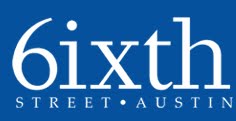 AUSTIN, Texas – October 9, 2008 – El Sol y La Luna is relocating to the northeast corner of Sixth and Red River streets, enhancing the stature of the East Sixth Street Historic Entertainment District as a world-class destination for music, fun and food.
AUSTIN, Texas – October 9, 2008 – El Sol y La Luna is relocating to the northeast corner of Sixth and Red River streets, enhancing the stature of the East Sixth Street Historic Entertainment District as a world-class destination for music, fun and food.The Interior Mexican restaurant, an Austin favorite since 1995, is set to debut its new Sixth Street home in spring 2009.
Owners Nilda de la Llata, Anna Salinas and Lynn Tiemann decided to move their restaurant from South Congress Avenue to capitalize on the growth opportunity and business diversity provided on Sixth Street.
El Sol y La Luna, which currently employs 25 people, has signed a long-term lease for 5,000 square feet at 600 E. Sixth St. This iconic business will join successful neighbors such as Alamo Drafthouse, B.D. Riley’s Irish Pub, Emo’s, Esther’s Follies, Maggie Mae’s, parkside restaurant and The Driskill Hotel.
“The relocation of El Sol y La Luna to Sixth and Red River represents another significant step forward in our efforts to build on and improve the Sixth Street brand, arguably Austin’s best-known brand,” Austin Mayor Will Wynn said. “With its unique food and Latin-flavored music, El Sol y La Luna will be a dynamic addition to an area known around the world for its bustling nightlife, live music and historic structures.”
El Sol y La Luna boasts a full menu of Interior Mexican cuisine; folk art by local and international artists; and live Latin American music. It received a 2008 Zagat Survey award and consistently has been named one of Hispanic Magazine’s Top 50 restaurants in the United States.
“Moving to this vibrant location in the Sixth Street district gives us more seating, a bigger kitchen, a big bar, and plenty of room for live music, dancing and artwork,” de la Llata said. “This space fits perfectly with our growth plan for El Sol y La Luna and the collective vision for Sixth Street.”
In 1995, de la Llata, Salinas and Tiemann invested their savings to convert a motel coffee shop on South Congress into what has become an Austin culinary and cultural staple. El Sol y La Luna played a key role in jump-starting redevelopment of Austin’s SoCo district.
Austin City Council Member Sheryl Cole said: “El Sol y La Luna will be an incredible draw for the thousands of conventioneers and visitors who come to Austin every year, particularly given the fact that it’s a short walk from the Austin Convention Center, the Hilton Austin and other Downtown Austin hotels. Furthermore, the arrival of El Sol y La Luna will add tremendously to the planned revitalization of the Waller Creek area. For Waller Creek to succeed, Sixth Street must succeed.”
Dick Clark Architecture, a downtown Austin firm that specializes in restaurants, will create the interior and exterior design—described as “cultural urban funky”—for the new location of El Sol y La Luna.
Nancy Burns, chair of the Downtown Austin Alliance, said: “El Sol y La Luna’s commitment to the Sixth Street district is a strong endorsement of the growing vitality of this area. El Sol y La Luna’s move demonstrates Sixth Street is a great place for everyone—and gives momentum to our efforts to make it an even better place. Thanks to the leadership of property owners Gary Wilson, Frank Hendrix, Jeff Brown and Vance Holmes, we are making our vision for Sixth Street a reality.”
Larry Craddock, chair of 6ixth Street Austin, said: “The addition of El Sol y La Luna further diversifies the Sixth Street district. Now, grandchildren and grandparents alike can enjoy El Sol y La Luna’s distinctive community-oriented blend of food, music and art. With El Sol y La Luna serving breakfast, lunch and dinner, the restaurant also helps accomplish one of the key goals of 6ixth Street Austin—to bolster daytime activity, making Sixth Street a true 18-hour destination.”
About El Sol y La Luna
El Sol y La Luna, the originator of “Sol Food,” is Austin’s laid-back home for Interior Mexican cuisine as well as live music, dancing and international folk art. El Sol y La Luna consistently has been named by Hispanic Magazine as one of the Top 50 restaurants in the United States. The business started in 1995 in the converted coffee shop of an Austin motel. For more information, visit www.elsolylalunaaustin.com.




 Follow us on twitter
Follow us on twitter
